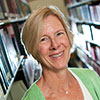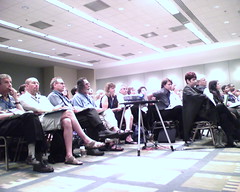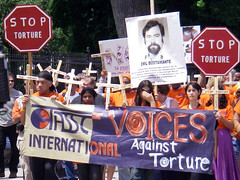This article is more than 5 years old.
I had a very early start this morning. I delivered Ron to my sister’s place in Springfield, got to hug my granddaughter (who is coincidentally up north to meet relatives this weekend), rushed back, caught the yellow-line Metro and was only 10 minutes late for my first session: Leading Technology-Driven Change: Theory & Practice. You can see from this picture what happens when you show up late to a popular session:
The speakers talked about their individual approaches to using leadership to guide change. They were: Joyce Ogburn from University of Utah, Felton Thomas, Jr. from Las Vegas-Clark Co. Libraries and Kathryn Deiss, Content Strategist from ACRL. I’m just going to list a few jewels (IMHO) from their talks, which were all quite informative and inspiring.
Ogburn:
- Universities are “untidy organizations” that operate on “delayed confounded feedback.”
- A quote from Patricia Battin: “Past strengths will become our liabilities.”
- Effective leadership’s challenge is to enhance your mission rather than the mission being defined by the technology.
Thomas:
- He quoted our old friend David Seaman on our profession not exactly being agents of change: “We’re moving the profession one funeral at a time.”
- On leaders carrying the burden of change: “It’s like going hunting and carrying the dog.”
- He is a big proponent of scenario building and did this for their “Model Efficiencies & Emerging Technologies (MEET)” project to maximize service efficiencies via RFID self-checkout and automated materials handling.
Deiss:
- Change is about 2 things: managing the action and managing the emotions that come with the action.
- From David Weinberger’s Everything is Miscellaneous: We all have a need to categorize (not just librarians!). The old model is “everything has its place.” With the explosion of technology, this has become “everything has every place.” The goal needs to be how to deal with this change and imagine new ways to structure ourselves and our services to reflect this new reality.
- On “choice overload”: in the presence of too many choices, most people will choose nothing, like a deer in the headlights. People are stunned by the extraordinary possibilities of too many choices. A leader’s role is to get people to focus on what they need to see rather than being paralyzed by seeing too many things.
I could go on, as I thought there was much offered in this session to think about, so if this topic interests you, let’s get together when I return and talk about it more in depth! (Sticking to my goal of not having my readers’ eyes glaze over from too much text).
Session Two
Erik steered me to this one which was several long blocks away at another hotel. And do you know that when deciphering the street names in program map without reading glasses, H Street looks just like M Street? Anyway, I finally made it (on time). The session was given by OCLC about their new WorldCat Local project, their new “discovery to delivery” service. OCLC is working with several libraries (U of Washington, Peninsula library system, State of Illinois, Ohio State University) to test a version of OpenWorldCat that is customizable by libraries and integrates with their ILS to reflect holdings, availability and includes keyword searching of library holdings, databases with OpenURL link resolution for fulltext access, access to local collections (currently CONTENT dm, but soon, Dspace). This was an exciting presentation to see as it’s what Erik’s been envisioning for some time. Their initial pilot partner, University of Washington, has it up and running (since 4/30). What I like is that it is attempting to provide a service that users have been asking for, one without silos, that gets them to their materials no matter where those are. It looks promising so far.
After this session, I had to hoof it to a third location many blocks away, so I consulted my map again (this time with my glasses on) and found I could stroll past the White House on the way. My White House experience changed my negative attitude toward the spread out nature of this conference, because I wandered into an adventure when I got there. It turns out a group was holding a protest. It was complete with cordoned off streets, mounted police, bullhorns, snipers on the White House roof and a batch of well behaved protesters against torture from the organization Tassc International. I lived in this area for my first 30 years and this was my first D.C. protest experience. Well worth the side trip!
OK, I’ll stop here and will report on the afternoon’s activities later. I’ve exceeded my self-imposed word length blog posting limit……


